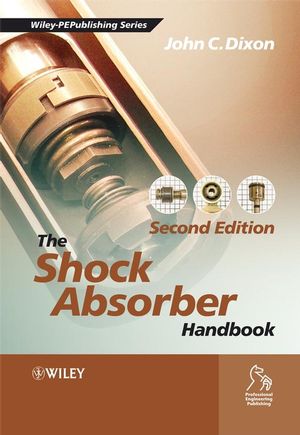The Shock Absorber Handbook, 2nd EditionISBN: 978-0-470-51020-9
Hardcover
432 pages
October 2007
 This is a Print-on-Demand title. It will be printed specifically to fill your order. Please allow an additional 10-15 days delivery time. The book is not returnable.
|
||||||
Acknowledgements.
1 Introduction.
1.1 History.
1.2 Types of Friction.
1.3 Damper Configurations.
1.4 Ride-Levelling Dampers.
1.5 Position-Dependent Dampers.
1.6 General Form of the Telescopic Damper.
1.7 Mountings.
1.8 Operating Speeds and Strokes.
1.9 Manufacture.
1.10 Literature Review.
2 Vibration Theory.
2.1 Introduction.
2.2 Free Vibration Undamped (1-dof).
2.3 Free Vibration Damped (1-dof).
2.4 Forced Vibration Undamped (1-dof).
2.5 Forced Vibration Damped (1-dof).
2.6 Coulomb Damping.
2.7 Quadratic Damping.
2.8 Series Stiffness.
2.9 Free Vibration Undamped (2-dof).
2.10 Free Vibration Damped (2-dof).
2.11 The Resonant Absorber.
2.12 Damper Models in Ride and Handling.
2.13 End Frequencies.
2.14 Heave and Pitch Undamped 1-dof.
2.15 Heave and Pitch Damped 1-dof.
2.16 Roll Vibration Undamped.
2.17 Roll Vibration Damped.
2.18 Heave-and-Pitch Undamped 2-dof.
2.19 Heave-and-Pitch Damped 2-dof Simplified.
2.20 Heave-and-Pitch Damped 2-dof Full Analysis.
3 Ride and Handling.
3.1 Introduction.
3.2 Modelling the Road.
3.3 Ride.
3.4 Time-Domain Ride Analysis.
3.5 Frequency-Domain Ride Analysis.
3.6 Passenger on Seat.
3.7 Wheel Hop.
3.8 Handling.
3.9 Axle Vibrations.
3.10 Steering Vibrations.
3.11 The Ride–Handling Compromise.
3.12 Damper Optimisation.
3.13 Damper Asymmetry.
4 Installation.
4.1 Introduction.
4.2 Motion Ratio.
4.3 Displacement Method.
4.4 Velocity Diagrams.
4.5 Computer Evaluation.
4.6 Mechanical Displacement.
4.7 Effect of Motion Ratio.
4.8 Evaluation of Motion Ratio.
4.9 The Rocker.
4.10 The Rigid Arm.
4.11 Double Wishbones.
4.12 Struts.
4.13 Pushrods and Pullrods.
4.14 Motorcycle Front Suspensions.
4.15 Motorcycle Rear Suspensions.
4.16 Solid Axles.
4.17 Dry Scissor Dampers.
5 Fluid Mechanics.
5.1 Introduction.
5.2 Properties of Fluids.
5.3 Chemical Properties.
5.4 Density.
5.5 Thermal Expansion.
5.6 Compressibility.
5.7 Viscosity.
5.8 Thermal Capacity.
5.9 Thermal Conductivity.
5.10 Vapour Pressure.
5.11 Gas Density.
5.12 Gas Viscosity.
5.13 Gas Compressibility.
5.14 Gas Absorbability.
5.15 Emulsification.
5.16 Continuity.
5.17 Bernoulli’s Equation.
5.18 Fluid Momentum.
5.19 Pipe Flow.
5.20 Velocity Profiles.
5.21 Other Losses.
5.22 The Orifice.
5.23 Combined Orifices.
5.24 Vortices.
5.25 Bingham Flow.
5.26 Liquid–Solid Suspensions.
5.27 ER and MR Fluids.
6 Valve Design.
6.1 Introduction.
6.2 Valve Types.
6.3 Disc Valves.
6.4 Rod Valves.
6.5 Spool Valves.
6.6 Shim Valves.
6.7 Valve Characteristics.
6.8 Basic Valve Models.
6.9 Complete Valve Models.
6.10 Solution of Valve Flow.
6.11 Temperature Compensation.
6.12 Position-Sensitive Valves.
6.13 Acceleration-Sensitive Valves.
6.14 Pressure-Rate Valves.
6.15 Frequency-Sensitive Valves.
6.16 Stroke-Sensitive Valves.
6.17 Piezoelectric Valves.
6.18 Double-Acting Shim Valves.
6.19 Rotary Adjustables.
6.20 Bellows Valves.
6.21 Simple Tube Valves.
6.22 Head Valves.
6.23 Multi-Stage Valves.
7 Damper Characteristics.
7.1 Introduction.
7.2 Basic Damper Parameters.
7.3 Mechanical Friction.
7.4 Static Forces.
7.5 Piston Free Body Diagram.
7.6 Valve Flow Rates.
7.7 Pressures and Forces.
7.8 Linear Valve Analysis.
7.9 Cavitation.
7.10 Temperature.
7.11 Compressibility.
7.12 Cyclical Characteristics, F(X).
7.13 Extreme Cyclic Operation.
7.14 Stresses and Strains.
7.15 Damper Jacking.
7.16 Noise.
8 Adjustables.
8.1 Introduction.
8.2 The Adjustable Valve.
8.3 Parallel Hole.
8.4 Series Hole.
8.5 Maximum Area.
8.6 Opening Pressure.
8.7 Area Coefficient (Stiffness).
8.8 Automatic Systems.
8.9 Fast Adaptive Systems.
8.10 Motion Ratio.
9 ER and MR Dampers.
9.1 Introduction.
9.2 ER–MR History.
9.3 ER Materials.
9.4 ER Dampers.
9.5 ER Controlled Valve.
9.6 MR Materials.
9.7 MR Dampers.
10 Specifying a Damper.
10.1 Introduction.
10.2 End Fittings.
10.3 Length Range.
10.4 F(V) Curve.
10.5 Configuration.
10.6 Diameter.
10.7 Oil Properties.
10.8 Life.
10.9 Cost.
11 Testing.
11.1 Introduction.
11.2 Transient Testing.
11.3 Electromechanical Testers.
11.4 Hydraulic Testers.
11.5 Instrumentation.
11.6 Data Processing.
11.7 Sinusoidal Test Theory.
11.8 Test Procedure.
11.9 Triangular Test.
11.10 Other Laboratory Tests.
11.11 On-Road Testing.
Appendix A: Nomenclature.
Appendix B: Properties of Air.
Appendix C: Properties of Water.
Appendix D: Test Sheets.
Appendix E: Solution of Algebraic Equations.
Appendix F: Units.
Appendix G: Bingham Flow.
References.
Index.



